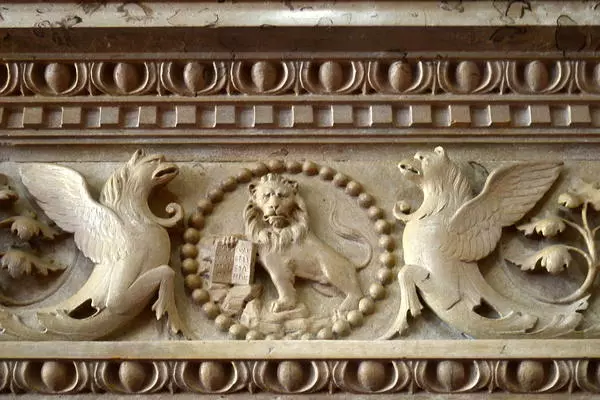The “Istria” fireplace, made in the style of the Italian Renaissance, is one of core details in the interior design of the Main Lobby of the Livadia Palace. The marble portal of the fireplace is of a light-chocolate shade, decorated with elegant carvings. It was commissioned from Italy. Its design uses motifs of Italian decor: a grotesque ornament with acanthus leaves, mythical creatures and heraldic symbols — the coats of arms of cities and a noble Venetian family.
Istria is a peninsula in the Adriatic Sea that once belonged to the Republic of Venice. In the center, on the frieze of the fireplace, is the coat of arms of the great city — the lion of St. Mark. The winged lion is the city’s symbol, representing Saint Mark (Mark the Evangelist). The lion stands on both sea and land, symbolizing the power of Venice. It holds an open book where an inscription in Latin “PAX TIBI MARCE, EVANGELISTA MEUS” (“Peace be with you, Mark, my evangelist”) is carved. The iconography of the coat of arms is quite diverse. In times of war, the book in the lion’s paws was replaced with a sword, while the image of a winged lion with a book in one paw and the other raised in a greeting gesture can be seen in modern Venice.
On the front of the left and right mantel support brackets is a carving of the coat of arms of one of the most influential Venetian families — the Barbarigo. Two members of this family were chosen as doges of Venice. On the shield of the coat of arms of the Barbarigo is a ribbon with three lions. There are six beards around the ribbon, three on each side. It is known that the first of the Barbarigos, after defeating his enemies, made a crown out of their beards and triumphantly returned to his hometown with it. The massive tent-like top of the fireplace was decorated by the “Brothers Axerio” company, which specialized in stucco and concrete decorations. The owners of this company were Italian citizens, brothers Anton Petrovich and Julius Petrovich Axerio. The top of the fireplace is decorated with a stylized composition based on the coat of arms of Florence: the heraldic Florentine lily is flanked on both sides by dolphins, supporting a wreath. Like the stucco decoration of the ceiling, this composition is made from gypsum, glue and a small admixture of paint.
Istria is a peninsula in the Adriatic Sea that once belonged to the Republic of Venice. In the center, on the frieze of the fireplace, is the coat of arms of the great city — the lion of St. Mark. The winged lion is the city’s symbol, representing Saint Mark (Mark the Evangelist). The lion stands on both sea and land, symbolizing the power of Venice. It holds an open book where an inscription in Latin “PAX TIBI MARCE, EVANGELISTA MEUS” (“Peace be with you, Mark, my evangelist”) is carved. The iconography of the coat of arms is quite diverse. In times of war, the book in the lion’s paws was replaced with a sword, while the image of a winged lion with a book in one paw and the other raised in a greeting gesture can be seen in modern Venice.
On the front of the left and right mantel support brackets is a carving of the coat of arms of one of the most influential Venetian families — the Barbarigo. Two members of this family were chosen as doges of Venice. On the shield of the coat of arms of the Barbarigo is a ribbon with three lions. There are six beards around the ribbon, three on each side. It is known that the first of the Barbarigos, after defeating his enemies, made a crown out of their beards and triumphantly returned to his hometown with it. The massive tent-like top of the fireplace was decorated by the “Brothers Axerio” company, which specialized in stucco and concrete decorations. The owners of this company were Italian citizens, brothers Anton Petrovich and Julius Petrovich Axerio. The top of the fireplace is decorated with a stylized composition based on the coat of arms of Florence: the heraldic Florentine lily is flanked on both sides by dolphins, supporting a wreath. Like the stucco decoration of the ceiling, this composition is made from gypsum, glue and a small admixture of paint.




